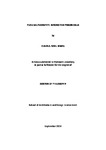Pudu Jail's Graffiti: Beyond the Prison Cells
| dc.contributor.supervisor | Maudlin, Daniel | |
| dc.contributor.author | Ismail, Khairul | |
| dc.contributor.other | Faculty of Arts, Humanities and Business | en_US |
| dc.date.accessioned | 2016-08-01T08:55:57Z | |
| dc.date.available | 2016-08-01T08:55:57Z | |
| dc.date.issued | 2015 | |
| dc.identifier | 10304031 | en_US |
| dc.identifier.uri | http://hdl.handle.net/10026.1/5142 | |
| dc.description | Full version unavailable due to 3rd party copyright restrictions. | |
| dc.description.abstract |
The aim of this thesis is to examine and analyse the images of graffiti contained within the portfolio of ‘Pudu Jail’s Graffiti (PJG)’, documented work from the abandoned prison facility in Kuala Lumpur, Malaysia, between 2002 and 2003. The objective has been to discover whether the ‘Pudu Jail’s Graffiti’, has a distinct visual narrative(s) compared with other prison graffiti research, concluding that its qualities lies in the complexity of visual cultures brought within the space of the prison cells. The prison graffiti retrieved from this portfolio has been analysed through a process of qualitative review; in order to find its thematic alignments based on comparative categorical contexts. This research will assess the concepts of the proposed themes of the PJG (there are ten themes such as Names, Time, Food, Religious gates, God(s), etc.) noting that the graffiti’s visual and textual narrative context was based on the local, vernacular culture, and social influences, which remained as part of the inmates’ or the cells’ previous occupants memories and the cultural embodiment that they had reflected onto the cell walls. It will look into the PJG’s significance and function, which contained a mixture of memories, events, places, professions of love, religious commitments and various tell-tale signs of messages that seemed to have been made exclusively for the inmates themselves. These personalised marks would throw light on the relationship between the inmates and the prison cells’ embodiment of their narratives. Thus, this research represents a continued effort to obtain an updated description of prison graffiti by finding an alternative approach within prison graffiti research. Combining both elements of the research, namely the meaning of the images and the acknowledgment of the space in which they reside, may lend greater argument to prison graffiti research and reveal the deeper connections that graffiti may have towards its cultural surroundings. | en_US |
| dc.language.iso | en | en_US |
| dc.publisher | Plymouth University | en_US |
| dc.subject | Prison Art | en_US |
| dc.subject | Graffiti | en_US |
| dc.subject | Malaysia | en_US |
| dc.subject | Prison Graffiti | en_US |
| dc.title | Pudu Jail's Graffiti: Beyond the Prison Cells | en_US |
| dc.type | Thesis | |
| plymouth.version | Edited version | en_US |
| dc.identifier.doi | http://dx.doi.org/10.24382/4908 |
Files in this item
This item appears in the following Collection(s)
-
01 Research Theses Main Collection
Research Theses Main


